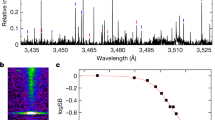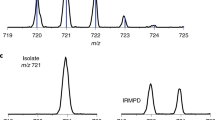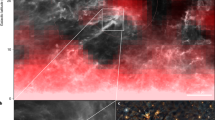Abstract
THE visible-region crystal-field spectra of Fe2+ and Fe3+ ions located in silicate minerals show several similar features, in particular a number of relatively sharp bands marking field-independent transitions, which are difficult to assign unless attendant chemical analyses are available. Three absorption bands at 6200 Å, 4430 Å and 3800 Å in optical spectra of Type I supernova were recently assigned1,2 to transitions within octahedral Fe3+ ions in andradite garnet, while two other bands at 5100 Å (19,600 cm−1) and 5700 Å (17,500 cm−1) were attributed to Fe2+ ions in almandine garnet. Runciman3 also feels that the supernova bands are due mainly to Fe, but he suggests that they may mark transitions in Fe2+ ions in pyroxene minerals. Many stars have appreciable excess emission at 10 and 20 µm, the origin of which has been attributed to circumstellar silicates4–7, possibly orthopyroxenes and olivines.
This is a preview of subscription content, access via your institution
Access options
Subscribe to this journal
Receive 51 print issues and online access
$199.00 per year
only $3.90 per issue
Buy this article
- Purchase on Springer Link
- Instant access to full article PDF
Prices may be subject to local taxes which are calculated during checkout
Similar content being viewed by others
References
Manning, P. G., Nature, 226, 829 (1970).
Manning, P. G., Nature, 227, 1121 (1970).
Runciman, R. A., Nature, 228, 843 (1970) (this issue).
Low, F. J., and Krishna Swamy, K. S., Nature, 227, 1333 (1970).
Knacke, R. F., Gaustad, J. E., Gillet, F. C., and Stein, W. A., Astrophys. J. Lett., 155, L189 (1969).
Gillet, F. C., Low, F. J., and Stein, W. A., Astrophys. J., 154, 677 (1968).
Woolf, N. J., and Ney, E. P., Astrophys. J. Lett., 155, L181 (1969).
Bloch, M., Chalonge, D., and Dufay, J., Ann. d'Astrophys., 24, 315 (1964).
Wild, P., Orion Schaffhausen, 8, 333 (1963).
Ford, W. K., and Rubin, V. C., Pub. Astron. Soc. Pac., 80, 466 (1968).
Ford, W. K., and Rubin, V. C., Pub. Astron. Soc. Pac., 79, 322 (1967).
Berkes, J. S., Materials Research Monograph, No. 2 (Pennsylvania State University, University Park, Pennsylvania).
White, W. B., and Keester, K. L., Amer. Mineral., 51, 774 (1966).
Faye, G. H., Canad. Mineral., 9, 403 (1968).
Grum-Grzhimailo, S. V., Boksha, O. N., and Varina, T. M., Kristallografiya, 14, 339 (1969).
Manning, P. G., Canad. Mineral., 9, 237 (1967).
Burns, R. G., Mineralogical Applications of Crystal Field Theory (Cambridge Univ. Press, 1970).
Huffman, D. R., Astrophys. J., 161, 1157 (1970).
Author information
Authors and Affiliations
Rights and permissions
About this article
Cite this article
MANNING, P. Origin of the Iron Bands in Supernovae Spectra. Nature 228, 844–845 (1970). https://doi.org/10.1038/228844a0
Received:
Issue Date:
DOI: https://doi.org/10.1038/228844a0
This article is cited by
-
Presence of Two Fe3+ Bearing Minerals in Interstellar Dust
Nature Physical Science (1971)
-
Silica Minerals in Interstellar Dust
Nature Physical Science (1971)
-
Is Pluto an Iron-rich Planet?
Nature (1971)
-
Wavelength Shifts of Intensity Minima in Type I Supernova Spectra
Nature Physical Science (1971)
Comments
By submitting a comment you agree to abide by our Terms and Community Guidelines. If you find something abusive or that does not comply with our terms or guidelines please flag it as inappropriate.



